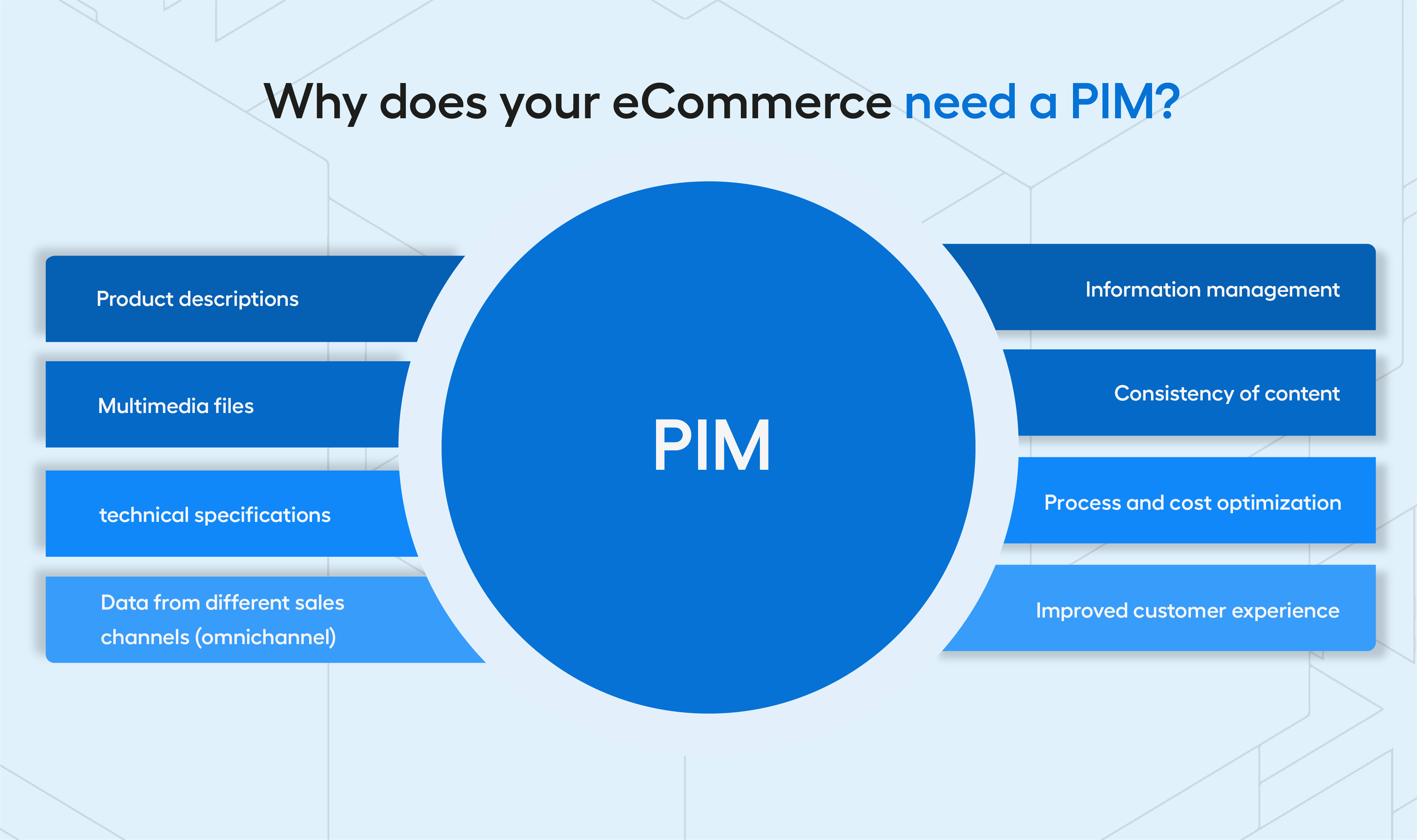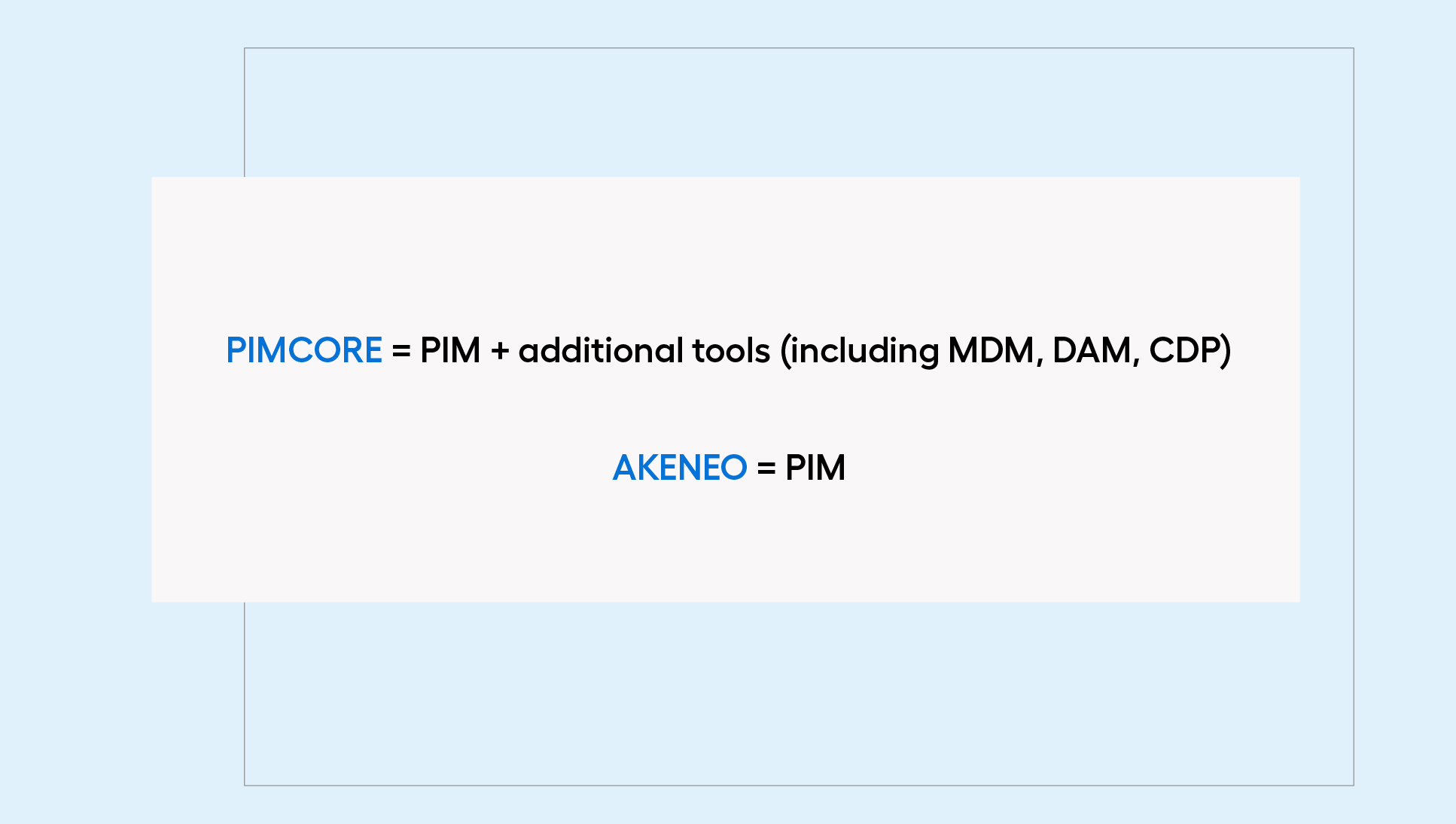Up-to-date product information, error minimization, and optimization of daily work- these factors will undoubtedly have a positive impact on effective sales in your online store and, consequently, increase customer satisfaction. The PIM (Product Information Management) system can help achieve these effects. What do you need to know about it? Which specific system among the most popular ones is worth choosing? Is it better to opt for PimCore or Akeneo? You'll find out all about this by reading this article!
PIM - why is Product Information Management important in an online store?
The primary purpose of PIM systems is product information management (though, as you'll find out, not only). PIM collects product data (including technical data, marketing descriptions, photos, prices, and inventory information) from all sources connected to your online store (e.g., ERP or CRM systems, spreadsheets, or files from suppliers) into a single organised database. This information is then transmitted to all communication channels - both to the sales platform itself and marketplaces or mobile apps. Such a solution not only optimises the process of managing an online store but also shortens the time needed to introduce products to the market. However, these aren't the only benefits of implementing PIM. Are you curious about what else you can achieve with this system?
Why is it worth managing product information in your eCommerce?
Are you expanding your online store and planning to broaden your offer? Do you manage a diverse assortment (with complex technical specifications, e.g., furniture measurements or technical parameters for hardware)? Or maybe you simply want to increase the efficiency of your eCommerce? In any case, PIM is at your disposal. This solution will primarily help catalogue and systematise all data without manually entering them (which may become impossible at a certain stage of development). But the benefits of PIM don't end there. Thanks to Product Information Management, you can:
- optimise costs - managing product data using PIM allows for efficient resource management, reducing the need for manual entry and data updates to a minimum. This means lower operational costs and allows employees to focus on more strategic tasks.
- reduce the risk of errors - through centralization, standardisation, and organisation of all data, and also by limiting the frequency of manual data entry, the system reduces the risk of errors, improving the quality of content on the e-store page.
- shorten time-to-market - with centralised product data management, PIM allows for faster product launches, which is helpful in a competitive eCommerce environment.
- enrich the product page - richer content on the product page can attract customers and influence their purchasing decisions. PIM facilitates managing content related to products, such as descriptions, photos, videos, and reviews.
- easily manage multiple channels - PIM enables uniform product data management for various sales channels, such as online stores, mobile apps, and marketplaces.
- reduce the number of returns - thanks to precise and consistent product data management, customers receive more comprehensive and consistent product information. This translates into more certainty of purchase and, consequently, fewer returns.

PimCore vs. Akeneo: Which PIM system is better for your e-store?
You've decided to implement a PIM system for your eCommerce. However, that's just the beginning of the decisions you have to make. Up next is choosing the specific PIM system that meets all your store's needs. There are approximately 50 Product Information Management solution providers on the market. Each varies based on software type (e.g., open-source, SaaS, etc.), maximum data handling capacity, and the range of functions. PimCore and Akeneo are among the most preferred PIMs, being the choice of brands like Audi, T-Mobile, and Ikea for PimCore and Sephora and Auchan for Akeneo. Discover what makes them popular, understand their capabilities, similarities, and differences – all in our detailed comparison.
PimCore vs. Akeneo: What's better for your eCommerce?
Both PimCore and Akeneo offer standard PIM features, enabling automated product management. Built on an open-source engine (however, the Enterprise version of Akaneo is based on a SaaS solution), both rely on the PHP language. While both were designed to cater to the same need (storing, managing, enriching, and distributing data), their applications differ significantly. Here's what to consider when deciding between the two:
Costs
It's no surprise that cost is a key factor when evolving platforms. Comparing PIM system costs isn't straightforward, as both PimCore and Akeneo have different versions, and expenses might ultimately depend on the degree of customization and e-shop needs.
PimCore is available in a free version (Community Edition), a paid Enterprise edition (offering all business tools, e.g., external integrations or translations), and a cloud version with three data management tiers (Starter, Professional, and Ultimate). Akeneo offers three versions: free, paid Enterprise, and Growth. The last one lacks some advanced features of the paid version but comes with consistent support and updates, absent in the free version. It might suit businesses planning to transition from the free to the paid edition.
When analyzing costs, it is also worth mentioning technical support - in the case of the free version of Akeneo, users can benefit from the support of a community of developers. In the case of the paid version, the help of qualified specialists is provided. On the other hand, when opting for PimCore, its users can choose to purchase an additional package of fixed support hours (20 hours per month).
Choosing between PimCore and Akeneo, cost-wise, depends on individual needs and business models. While the free versions offer only basic features and integrations, the costs of paid versions largely hinge on individual demands. Pricing for both always depends on specific e-shop requirements, making it hard to pinpoint which offers better value. However, given PimCore's broader functionality, its upper implementation cost limit might be higher.
Product management
Product management is key in eCommerce, irrespective of business scale. Depending on the variety and specifics of offered products, organising them might require different complexity levels. What tools do PimCore and Akeneo offer in this realm?
Within PimCore, product hierarchy is tree-structured, allowing unlimited assignment of product variants and attributes (e.g., color, brand, size). Its built-in data management mechanism ensures control over various data types, such as product descriptions, media, or supplier info.
Akeneo, on the other hand, uses the Entity Attribute Value (EAV) model, resulting in a more flat data structure compared to PimCore. Each product variant can have up to two attributes, which might be limiting for complex offerings. Yet, Akeneo offers other functionalities like a drag-and-drop panel for attribute assignment and content verification with improvement suggestions.
Functionalities and extensions
While Akeneo is a standard PIM system, PimCore goes beyond basic capabilities. PimCore incorporates features typical for other applications like MDM (Master Data Management), DAM (Digital Asset Management), and CDP (Customer Data Platform). Thus, with PimCore, you can leverage functionalities such as:
- Digital asset storage and management, e.g., photos or videos.
- Content creation tools for diverse product descriptions, multimedia integration, and translations as needed.
- Brand management, which ensures consistent branding, checking elements like logos, colours, fonts, and slogans for coherence.
- Data analysis tools to study customer behaviours and recognize market trends.
- Comprehensive key data management – PimCore allows holistic product information management, aiding not just in data collection (locations, attributes, categories, etc.), but also in standardisation, duplication, synchronisation, and history creation or restoration.

Scalability
If you're planning to expand your e-business in both domestic and international markets, scalability should be a crucial factor in choosing a system. High scalability allows you to adapt the platform to large or global environments. PimCore's intuitive data model can easily handle millions of products with thousands of attributes. Additionally, it allows for the connection of any data and effortlessly adapts to add-ons or real-time changes.
On the other hand, since Akeneo uses EAV instead of an MDM system (like PimCore), its scaling, modelling, and data processing might be limited to some extent. However, Akeneo's developers ensure ongoing scalability enhancements, continuously improving their PIM.
Additional integrations
Both Akeneo and PimCore offer integration possibilities with other systems using API - in this regard, PimCore stands out again, offering significantly more flexibility. PimCore's technologies are distinguished by their "connect anything" approach. This means that the system can collect various types of data, regardless of their nature or source. Additionally, PimCore works perfectly with solutions such as Magento or SAP. Thanks to this flexibility, you can freely tailor this system to specific needs and used software.
On the other hand, Akeneo's limited approach to integration stems from the concept behind the system - the developers' mission was to focus on the most professional product information management without additional integration features. This doesn't mean integrations are impossible within Akeneo - the system has its integration tools that allow data export and import in Excel or CSV formats. However, Akeneo doesn't often support more advanced technologies, which can somewhat be supplemented by downloading additional overlays.
Comparison of PimCore vs. Akeneo - similarities and differences
Choosing the PIM system best suited to your eCommerce needs is a complex task that requires careful consideration of individual pros and cons. To make your decision easier, we've presented the key differences between PimCore and Akeneo in the table below.
| Area | PimCore | Header |
|---|---|---|
| Cost | Free Community version, paid Enterprise version, three levels of cloud versions (Starter, Professional, and Ultimate). | Free Community version, paid Enterprise version, Growth version. |
| Product management | Product hierarchy in the form of a tree - unlimited number of attributes assigned to products. Advanced data management, such as product descriptions, media, delivery information. | Simplified product hierarchy - maximum of two attributes. Features improving product management (e.g. content quality verification). |
| Functionalities and extensions | Additional MDM, DAM, CDP features, digital asset management, B2C and B2B channel sales, content personalization, content translation, data hierarchy setting. | Typical PIM system without additional features. |
| Scalability | Almost unlimited scalability. | Scaling, modeling, and data processing might be limited. |
| Additional integrations | Flexibility in integrations using API. | Limited approach to integration, possibility of extensions. |
In this comparison, PimCore is a more flexible solution in terms of both functionality and scalability. On the other hand, Akeneo is more focused on the core PIM functions, mainly allowing effective product information management. Ultimately, the choice between PimCore and Akeneo will always depend on the individual needs of the online store, the budget, and the level of advancement in managing product data.
Will you opt for PimCore or invest in Akeneo?
Regardless of whether you decide to implement PimCore or Akeneo, in either case, deploying a PIM system will bring numerous benefits. Through effective product data management, you can optimise costs, reduce the time to market for products, and also increase conversion rates. However, to fully leverage the potential of these systems, it's essential to have a comprehensive understanding of your eCommerce needs. Thoughtful and thorough consideration of all areas of operation will allow you to choose a solution that perfectly adapts to your business's characteristics. What decision will you make to invest in the growth of your business? If you still have doubts, we'd be happy to help you implement a PIM system that will elevate your eCommerce to a higher level of efficiency and competitiveness.



